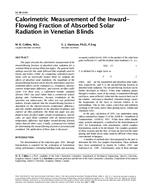Description
This paper presents the calorimetric measurement of the inward-flowing fraction of absorbed solar radiation for a venetian blind at various blind slat angles. The general methodology used for this study followed that originally used by Klems and Kelley (1996). By conducting controlled experiments with an electrically heated blind (to simulate the effects of absorbed solar radiation), the magnitude of the inward-flowing fraction can be directly determined, and environmental effects can be evaluated (i.e., irradiance, interior/ exterior temperature difference, and exterior air-film coefficient). For these tests, a calibration transfer standard (Bowen 1985) was used rather than a commercial sealed-glazing unit. Furthermore, because irradiation of the specimen was unnecessary, the entire test was performed indoors. Results indicate that the inward-flowing fraction is dependent on the interior/exterior temperature difference, and only slightly dependent on the absorbed irradiance and exterior air film coefficient. The blind slat angle was also found to have an effect under certain circumstances. Specifically, an open blind combined with an interior/exterior temperature difference had higher inward-flowing fraction values than all other cases. Finally, a proposed test method for determining the inward-flowing fraction is presented and examined. The application of these data is discussed.
Units: Dual
Citation: Symposium, ASHRAE Transactions, vol. 105, pt. 2, Seattle 1999
Product Details
- Published:
- 1999
- Number of Pages:
- 9
- File Size:
- 1 file , 1.3 MB
- Product Code(s):
- D-7463




